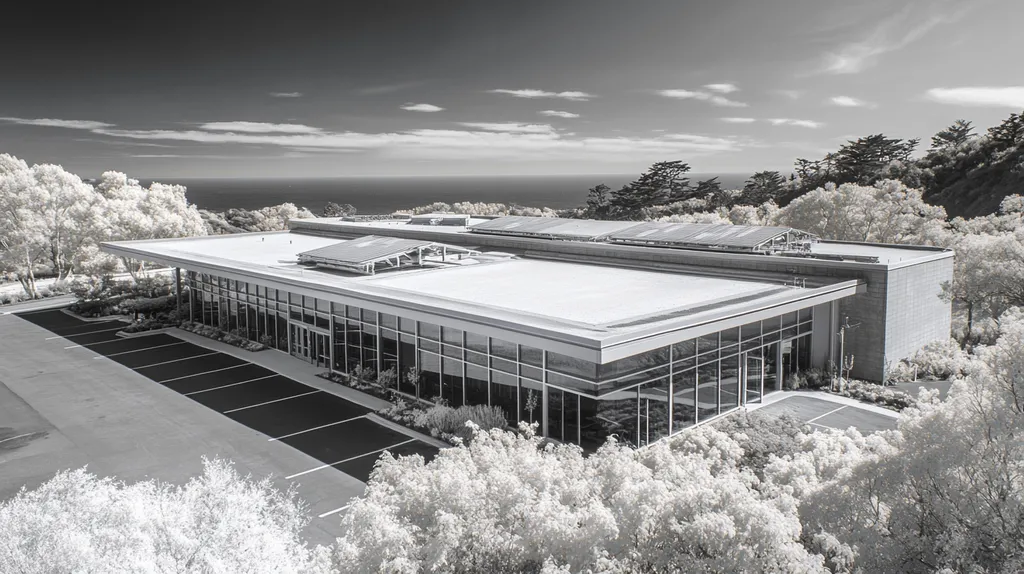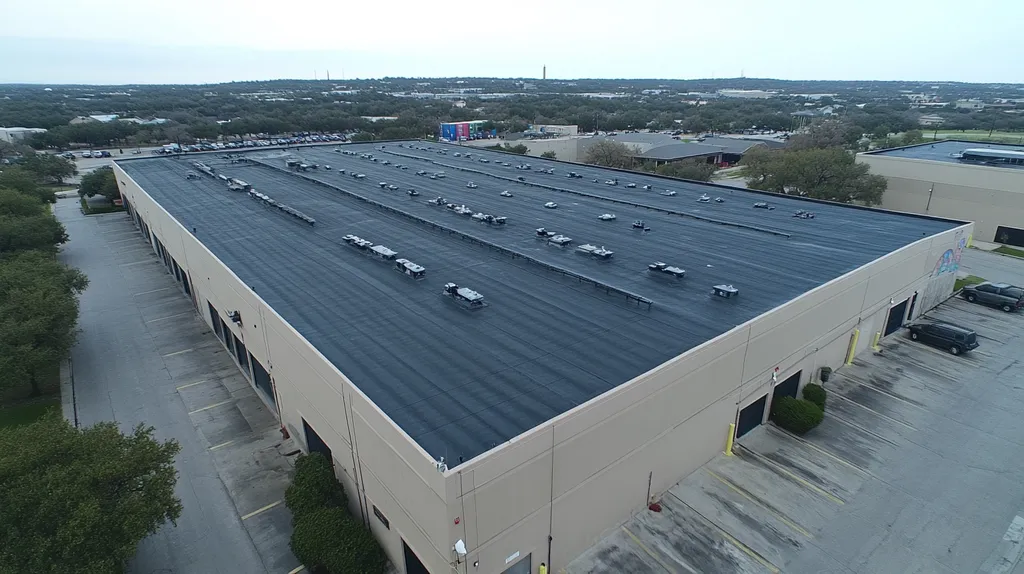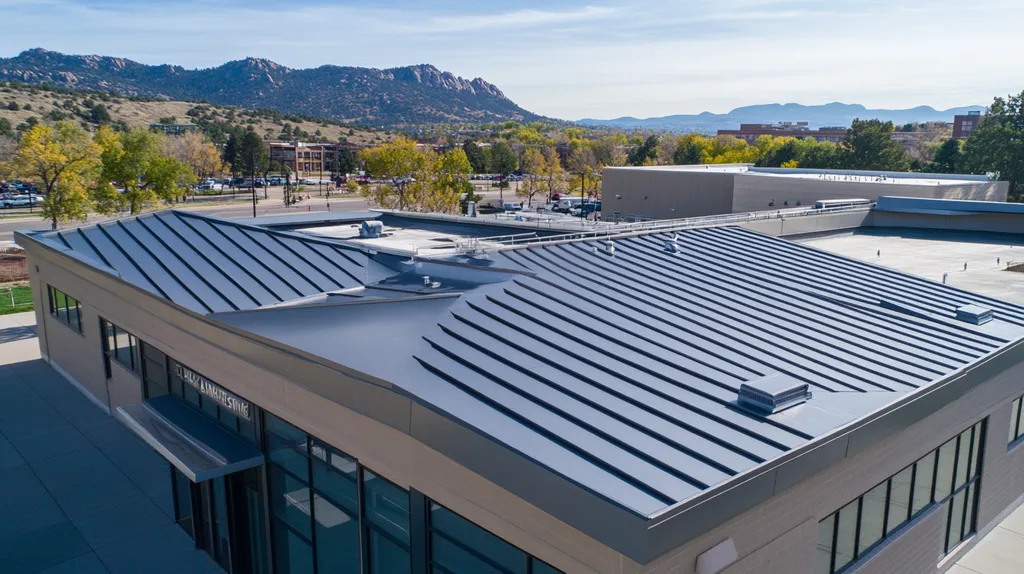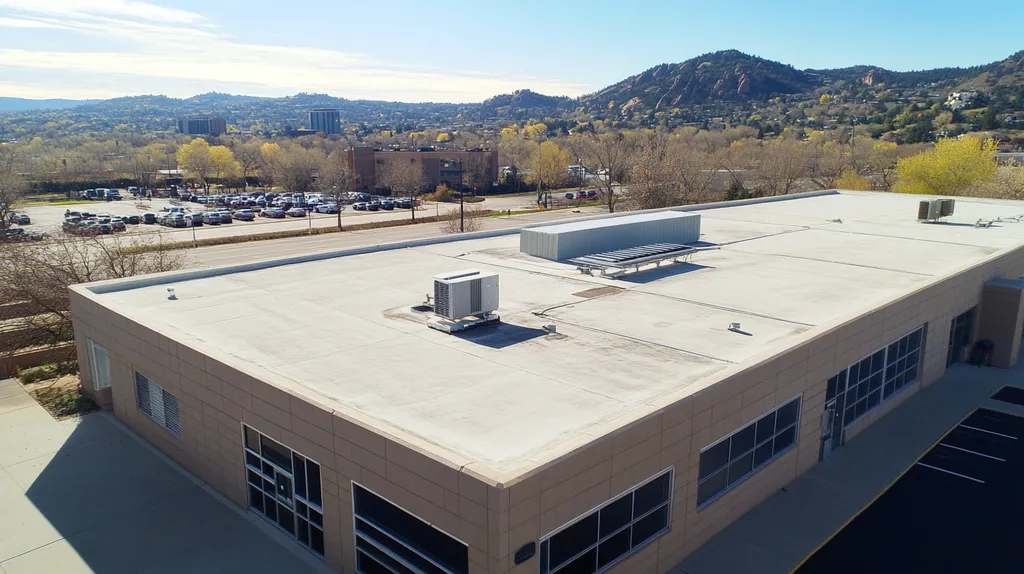When winter temperatures plummet, commercial building owners face a critical choice: wait until spring for roof coating or tackle the challenge head-on. This decision impacts millions in property value and operational costs across North America each year.
While conventional wisdom suggests hibernating until warmer weather, modern coating technologies and application methods are transforming winter from a roadblock into an opportunity. Yet misconceptions about cold-weather applications continue to drive costly delays and premature roof failures.
This comprehensive guide cuts through common myths, exploring the realities of winter coating applications and providing evidence-based strategies for success in even the most challenging conditions.
SECTION 1: COMMON MISCONCEPTIONS
Think your commercial roof is just a giant umbrella that occasionally hosts HVAC units? Think again! The world of roof coatings is swimming in misconceptions that cost building owners millions each year in premature replacements and sky-high energy bills.
From treating high-performance coatings like bargain-bin paint to assuming winter applications are doomed to fail, these myths aren’t just wrong – they’re potentially devastating to your building’s health and your bottom line.
Myth: Roof Coatings Are Just Decorative Paint
If you’ve ever dismissed roof coatings as glorified paint, you’re not alone – but you’re missing out on a technological marvel that’s more Iron Man suit than finger paint. When installed properly, these coating systems can match or even outperform your original roof.
These sophisticated systems act like a force field against Mother Nature’s arsenal. UV rays? Blocked. Thermal shock? Absorbed. Water infiltration? Denied entry!
Modern coating formulations pack more protective punch than a heavyweight champion. Some fluid-applied systems create seamless membranes that laugh in the face of leaks while reflecting harmful rays.
The real magic happens when these coatings transform your energy bills from scary to sensible. They’re not just protecting your roof – they’re protecting your wallet too! (source: Facilitiesnet)
Winter Application Damages Coating Integrity
Oh, the dreaded winter coating conundrum! Many building owners curl up and hibernate when temperatures drop, assuming coating applications must wait for warmer days. But here’s the chilly truth: modern coating technology doesn’t need a summer vacation.
Today’s advanced formulations are like polar bears of the roofing world – they’re perfectly comfortable in cold conditions. Many high-performance coatings bond beautifully even when Mercury takes a dive.
Winter applications can actually be your secret weapon. Lower humidity often means better adhesion, while cooler temperatures can create ideal curing conditions for certain products.
Plus, waiting for perfect weather is like waiting for all traffic lights to turn green simultaneously – you’re missing valuable protection time while your roof faces winter’s worst alone.
Coatings Are Ineffective on New or Well-Maintained Roofs
Thinking a new roof doesn’t need coating is like refusing to wax a new car – you’re missing a golden opportunity for premium protection! New roofs are perfect candidates for coating systems.
Fresh installations provide an ideal foundation for protective coatings. It’s like giving your roof a suit of armor before sending it into battle against UV rays, acid rain, and thermal shock.
Well-maintained roofs benefit too! Adding a coating system to a properly maintained roof is like upgrading your smartphone’s security before it gets hacked – proactive protection beats reactive repairs every time.
The best part? Early coating application often extends warranty coverage and can double or triple your roof’s effective service life. Now that’s what we call smart business!
SECTION 2: PRACTICAL IMPLICATIONS
Imagine your roof as a fussy dance partner – it needs just the right conditions to perform its best! When winter rolls in, that partnership gets particularly tricky. Temperature drops turn simple coating jobs into high-stakes challenges that can make or break your roof’s long-term performance.
Like a temperamental chef who needs perfect ingredients, winter coating applications demand precise conditions and expert handling. Get it wrong, and you might find yourself dealing with a roof that peels faster than a sunburned tourist!
Effects of Cold Temperatures on Coating Adhesion
Cold temperatures turn your coating into a reluctant hugger – it just doesn’t want to bond with your roof! Think of it like trying to spread cold honey versus warm honey; when temperatures plummet, even the best coatings become stubborn and uncooperative.
Below 50°F, most coatings enter their comfort zone’s danger zone. They become as rigid as a frozen rubber band, losing the flexibility needed to handle your roof’s natural expansion and contraction dance.
The curing process slows to a snail’s pace in cold weather, like watching paint dry in slow motion. This extended vulnerability period leaves your coating susceptible to all sorts of mischief from Mother Nature.
When coating molecules can’t properly link arms and form their protective barrier, you’re left with a shield full of weak spots. These vulnerable areas become prime targets for moisture infiltration and wind uplift.
Preparing Roof Surfaces for Winter Coating Application
Winter roof preparation is like getting ready for an Olympic event – every detail matters! Your roof surface needs to be cleaner than a surgeon’s operating table, and twice as dry.
Ice and frost are sneaky saboteurs that love to hide in microscopic roof pores. Even a hint of trapped moisture can turn your coating job into a expensive game of “find the leak” come springtime.
Smart contractors treat winter prep like a military operation. They deploy heat blankets like tactical gear, warming surfaces to optimal temperatures for maximum coating adhesion.
Rushing through winter preparation is like skipping your morning coffee – everything that follows is bound to go wrong. Each step requires patience, precision, and often specialized equipment to create ideal application conditions.
Impact of Winter Moisture and Ice on Coating Performance
Winter moisture is the ninja of roofing problems – silent, sneaky, and potentially devastating. It can slip beneath your coating faster than a cat on a hot tin roof, creating hidden blisters that expand like bubble gum.
Ice formation plays demolition derby with your coating system. As frozen moisture expands, it can create micro-cracks that grow into major pathways for water infiltration.
The freeze-thaw cycle turns your roof into a rollercoaster of expansion and contraction. Without proper flexibility, coatings can crack and separate, leaving your roof as exposed as a penguin in the desert.
Temperature fluctuations between day and night create condensation opportunities that would make a meteorologist dizzy. This daily moisture dance can compromise even the most carefully applied coating system.
SECTION 3: COST OF MISINFORMATION
Think your winter coating decisions only affect this season’s budget? Think again! Every year, commercial building owners flush millions down the drain faster than a frozen pipe burst by falling for common coating myths. The real kicker? These costly misconceptions don’t just nibble at your maintenance budget – they take giant bites out of your building’s long-term value.
Financial Risks of Improper Winter Coating Application
Winter coating mishaps are like expensive dominos – one wrong move triggers a cascade of costly consequences. When temperatures drop, improper application can turn your protective coating into a peeling nightmare faster than you can say “warranty void.”
We’re talking repair bills that would make your accountant cry. A botched coating job doesn’t just fail to protect – it creates new vulnerabilities that turn minor issues into major expenses.
The worst part? These failures often show up during the most brutal weather conditions, when emergency repairs cost triple and your building’s contents face maximum risk.
Think you’re saving money by hiring the lowest bidder? That bargain-basement coating job could cost you ten times more in repairs than doing it right the first time.
Increased Maintenance Due to Misunderstood Coating Capabilities
When coating capabilities are misunderstood, your maintenance schedule transforms from routine check-ups into a never-ending game of whack-a-leak. Each misapplied coating becomes a ticking time bomb of future repairs.
Every skipped surface preparation step or ignored temperature requirement creates weak spots that demand constant attention. It’s like trying to patch a leaky boat while sailing through a storm – expensive, frustrating, and ultimately futile.
The maintenance spiral gets worse as building systems start playing an expensive game of dominoes. A compromised coating leads to moisture intrusion, which triggers insulation failure, which cranks up energy costs – and down goes your operating budget!
Properly installed coating systems can match or even outperform your original roof, turning that maintenance nightmare into a dream of efficiency and durability. (source: Facilitiesnet)
Budget Implications of Delayed or Avoided Coating Projects
Playing chicken with winter coating projects is like gambling with your building’s future. That “money-saving” delay often snowballs into budget-crushing emergency repairs when spring finally arrives.
Every month without proper coating protection is another month your roof faces the elements unarmored. Those “minor” issues you’re ignoring? They’re multiplying faster than rabbits in springtime.
The energy efficiency hit alone can drain your budget faster than a coffee shop drains your morning wallet. Uncoated roofs in winter work your HVAC system harder than a personal trainer during resolution season.
Smart property owners know that timing is everything. Waiting for “perfect” conditions is like waiting for traffic to disappear – you’re just watching your protection window (and budget) slip away.
SECTION 4: REALITY CHECK
Think your commercial roof needs to hibernate through winter? Wake up and smell the innovation! Modern coating technologies are revolutionizing winter applications faster than a snowplow clearing Main Street. While old-school building owners shiver in indecision, savvy facility managers are discovering that winter coating isn’t just possible – it’s often preferable!
Advances in Cold-Weather Compatible Coating Technologies
Today’s cold-weather coatings are like winter-sports champions – they thrive in conditions that used to sideline their predecessors. These high-tech formulations laugh in the face of frost, maintaining flexibility and adhesion even when temperatures plummet.
Modern silicone and specialized acrylic coatings can bond beautifully at temperatures as low as 20°F. It’s like having a superhero cape that actually works better in the cold!
These advanced formulations come equipped with rapid-cure technology that’s like hitting the fast-forward button on traditional coating timelines. While old-school products might have taken days to cure, these newcomers can set up shop in hours.
The best part? These coatings maintain their protective superpowers long after application, creating a shield that fights off UV rays, moisture, and thermal shock like a rooftop guardian angel.
Manufacturer Guidelines for Winter Roof Coating Applications
Modern coating manufacturers have turned winter application into a science as precise as a Swiss watch. Their guidelines read like a championship playbook, with every condition and variable carefully mapped out for success.
Surface preparation requirements have evolved beyond the simple “clean and dry” mantra. Today’s protocols include dew point calculations, substrate temperature monitoring, and specialized moisture detection techniques.
Application windows are now defined with laser precision. Instead of vague temperature ranges, manufacturers specify exact conditions for optimal performance, right down to the relative humidity sweet spot.
These aren’t just suggestions – they’re your roadmap to roofing victory. Following them transforms what used to be a game of chance into a reliable science.
Proven Benefits of Coating Commercial Roofs in Winter
Winter coating isn’t just possible – it’s packed with perks that would make summer applications jealous! When applied correctly, roof coatings provide unmatched UV protection and prevent ponding water damage while improving your facility’s energy efficiency. (source: Armour Roof Co)
Scheduling winter applications often means snagging premium contractors at off-peak rates. It’s like getting first-class service at economy prices – who doesn’t love that?
Winter applications can actually create better curing conditions for certain products. Lower humidity levels and controlled temperature rises can result in stronger bonds than those typical summer scorchers.
Plus, winter coating means your roof isn’t naked when spring storms roll in. It’s like giving your building an umbrella before the rain starts – timing that just makes sense!
SECTION 5: EVIDENCE-BASED ALTERNATIVES
Think your winter coating options are as limited as a penguin’s vacation choices? Think again! While old-school building owners shiver in indecision, modern coating technology is serving up a feast of cold-weather solutions that would make a polar bear jealous. But here’s the chilly truth: without the right combination of materials, methods, and expertise, your winter coating project could freeze up faster than a forgotten garden hose in January.
Selecting Elastomeric and Silicone Coatings for Winter Use
Modern elastomeric and silicone coatings are like winter athletes – they’re specifically trained to perform when temperatures take a nosedive. These cold-weather champions maintain flexibility even when other coatings turn brittle as candy canes.
Premium silicone formulations laugh in the face of frost, creating seamless membranes that stick better than a tongue to a frozen flagpole (though we don’t recommend testing that). When installed properly, these fluid-applied systems can match or even outperform your original roof, while their unmatched UV stability keeps harmful rays at bay.
Urethane coating systems have proven themselves the heavyweight champions of durability, standing strong against ponding water like a bouncer at an exclusive club. These tough-as-nails solutions create a weather-tight seal that keeps winter’s worst elements outside where they belong.
The right coating choice transforms your roof from winter wimp to cold-weather warrior. Just remember – manufacturer-approved contractors are essential for securing those coveted labor and material warranties that help you sleep soundly through winter storms. (source: Facilitiesnet)
Utilizing Roof Surface Heating and Conditioning Techniques
Smart contractors treat winter surface prep like a sophisticated dance routine – every move matters! Modern heating systems are the behind-the-scenes choreographers, creating perfect conditions for coating success.
Infrared heating technology turns your roof into a cozy workshop, maintaining ideal application temperatures even when Jack Frost is working overtime. These systems warm surfaces with the precision of a master chef, ensuring every square inch is ready for maximum coating adhesion.
Strategic heat blanket deployment creates controlled curing zones that would make a greenhouse jealous. This targeted approach transforms tricky winter applications into predictable, reliable installations.
Temperature monitoring systems keep watch like helicopter parents at a school dance, ensuring conditions stay perfect throughout the application process. When every degree matters, this vigilance transforms potential disasters into roofing victories.
Partnering with Certified Installers for Winter Applications
Certified installers are like winter coating ninjas – they’ve mastered the art of cold-weather application through years of specialized training. These pros know exactly how to navigate winter’s challenges with the precision of a Swiss watchmaker.
Their expertise isn’t just about knowing which buttons to push – it’s about understanding the complex dance between temperature, humidity, and material chemistry. They’re equipped with cutting-edge tools and techniques that turn winter challenges into opportunities.
These coating commandos come armed with specialized equipment that makes winter application look easier than building a snowman. From surface preparation to final inspection, they follow protocols more detailed than a holiday dinner recipe.
Working with certified pros means getting a roof that’s ready to tackle winter head-on. Their knowledge transforms what could be a risky venture into a reliable investment in your building’s future.
SECTION 6: TEST AND VERIFY
Think testing your winter roof coating is as simple as checking the weather app? Think again! Every year, building owners waste millions on failed applications because they skipped the crucial verification steps. Without proper testing, your coating project could turn into a frozen disaster faster than you can say “premature failure.”
Like a doctor checking vital signs before surgery, thorough testing transforms risky guesswork into reliable science. Skip these critical checks, and you might as well be throwing money off your roof!
Methods for Verifying Roof Surface Temperature Prior to Coating
Your infrared thermometer is like a roofing detective, sniffing out cold spots that could sabotage your coating project. One reading isn’t enough – you need a thorough investigation across your entire roof surface, especially those sneaky shaded areas!
Surface temperature mapping is like creating a weather forecast for your roof. Strategic measurement points help identify potential trouble zones where temperatures might dip below critical thresholds.
Dew point calculations aren’t just fancy math – they’re your crystal ball for predicting condensation issues. Get these calculations wrong, and your coating could end up with more bubbles than a champagne toast.
Smart contractors treat temperature verification like a championship game plan. They’re checking ambient conditions, surface readings, and material temperatures with the precision of a NASA launch countdown.
Inspection Protocols to Ensure Proper Coating Cure in Cold Weather
Winter coating inspections are like babysitting a temperamental toddler – they demand constant attention and perfect timing. Miss a critical check, and your coating could throw a tantrum that costs thousands to fix.
The first 24 hours after application are like watching paint dry – if that paint cost as much as a luxury car! Smart facility managers schedule regular checks during this crucial period to catch any early warning signs.
Thickness testing is your insurance policy against future failures. Using wet and dry mil gauges helps ensure your coating provides consistent protection across every square inch.
Document everything like you’re writing the world’s most detailed diary. Photos, measurements, and environmental readings create a paper trail that could save your warranty (and your budget) down the road.
Post-Application Monitoring and Performance Validation Strategies
Think your coating job is finished once it cures? That’s like assuming your car never needs maintenance after leaving the dealership! Smart building owners treat post-application monitoring like a long-term relationship – it needs regular attention to stay healthy.
Thermal imaging sweeps turn your roof into a heat map of potential problems. These high-tech scans can spot trouble brewing beneath the surface before it turns into a full-blown crisis.
Regular adhesion testing is like giving your coating a physical exam. Pull tests and core samples provide concrete evidence that your protection is still going strong.
Performance tracking should be as routine as checking your email. Creating detailed inspection schedules and maintenance logs helps catch small issues before they become budget-busting emergencies.
The Bottom Line
With over $1 billion in commercial roofing assets at risk each winter, facility managers can no longer afford to base coating decisions on outdated myths and misconceptions.
Modern cold-weather coating technologies, when properly selected and applied, can deliver superior protection even in challenging winter conditions.
The key to success lies in partnering with certified professionals who understand the science behind surface preparation, temperature monitoring, and post-application validation.
By embracing evidence-based winter coating strategies and rigorous testing protocols, building owners can extend roof life by 10-15 years while reducing energy costs by up to 30%.
The question isn’t whether to coat your roof in winter – it’s whether you can afford not to.
FREQUENTLY ASKED QUESTIONS
Q. Are commercial roofs just a type of decorative paint?
A. No, roof coatings are advanced protective systems, not mere decorative layers. These high-performance coatings enhance durability, energy efficiency, and protection against UV exposure and leaks. Treating them as just paint can lead to premature failures and costly repairs.
Q. How do cold temperatures affect industrial roof coating adhesion?
A. Cold temperatures can hinder coating adhesion because many products become less flexible and more difficult to bond. This can result in weak spots and compromised integrity, potentially leading to water infiltration and damage. Ensuring optimal temperatures is essential for a lasting application.
Q. What are the financial risks of a botched winter coating application on a commercial roof?
A. A poor winter application can lead to significant repair costs and increased vulnerabilities. Minor issues may escalate, leading to higher maintenance and emergency repair bills, especially during severe weather. This highlights the importance of proper application to protect your investment.
Q. Are there advancements in coatings that perform well during winter?
A. Yes! Modern cold-weather coatings are designed to bond effectively in low temperatures. These advanced formulations ensure flexibility and strong adhesion, making winter applications not only viable but often preferable for many building owners.
Q. How can I prepare my commercial roof for winter coating applications?
A. Preparation involves thorough cleaning to remove debris and ensure dryness. It’s crucial to eliminate any ice or frost that could hinder adhesion. Using heating methods to warm the roof and following manufacturer guidelines creates ideal conditions for successful winter applications.
Q. Why is testing important for commercial roof winter coatings?
A. Testing ensures accurate temperature readings and proper curing conditions. Skipping verification can lead to premature coating failures, resulting in costly repairs. Continuous monitoring post-application helps ensure the integrity of the coating and protects your investment.
Q. What types of coatings are best suited for cold-weather applications?
A. Elastomeric and silicone coatings are ideal for cold-weather use due to their flexibility and adhesion properties. These coatings remain effective at lower temperatures and effectively protect your roof from moisture and UV damage while ensuring longevity.










